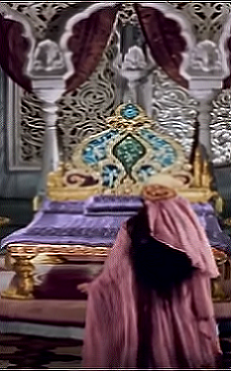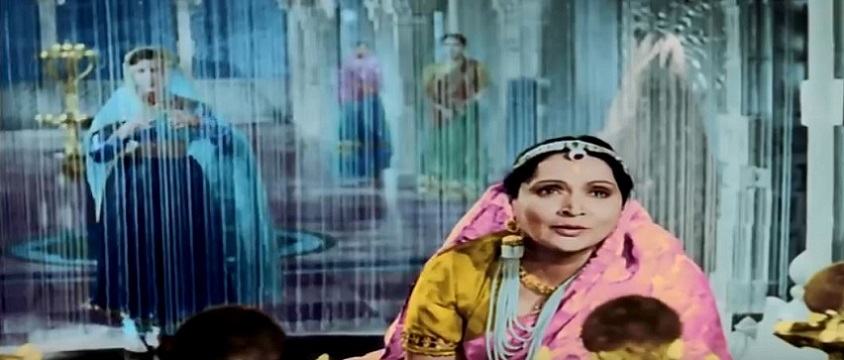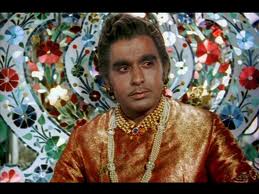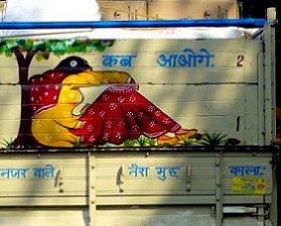Mughal-e-Azam

No, this is not an example of bad colourisation. Even in black and white it was not much better (left). This, perhaps, was the only ‘veiled’ composition that Asif- Mathur were not able to pull off. However, close ups of Madhubala behind this bead curtain are somewhat better (see picture later on this page).
This is a collection of articles archived for the excellence of their content. |
Mughal-e-Azam (Hindi-Urdu film from India/ 1960/ dir. K. Asif)
Facts about Mughal-e-Azam
The Times of India Crest EditionJuly 31, 2010
The movie was premiered in Mumbai's Maratha Mandir and released simultaneously in 150 theatres across the country.
Before every shot, Prithviraj Kapoor (who played Jalaluddin Mohammad Akbar) would look into a full-length mirror. When director K Asif asked the reason for the odd behaviour, Kapoor said he did it to 'get under the skin of the character'.
K Asif took nine years to make Mughal-e-Azam. In 1952, Jhansi Ki Rani became India's first movie to be shot in technicolour. Asif wanted to remake his film entirely in colour too, but it is said the distributors lost patience and settled for shooting two songs and the climax of the film in technicolour. Some 85 per cent of the movie was filmed in black-and-white. In November 2004, the Indian Academy of Arts and Animation restored, colourised and re-released the film in 100 per cent colour. This is the first full feature-length movie to be coloured and re-released in theatres in the history of cinema. Some English films have been coloured but only released in the home video format.
The colour version of the film was the first Indian movie to be released in Pakistan after Indian movies were banned there after the 1965 war.
A chorus of 100 singers accompanied Mohammed Rafi in the song Ae Mohabbat Zindabad.
Pyar Kiya Toh Darna Kya was shot in a Sheesh Mahal [set constructed] at a cost of Rs 10 lakh at a time when entire movies were made on that budget. Most thought financier Shapoorji Pallonji would go bankrupt filming this one song itself. The song was written and re-written more than a hundred times by lyricist Shakeel Badayuni before music director Naushad approved of it. To provide the reverbration effect in the song, Lata Mangeshkar recorded it in a bathroom.
The director had initially thought he would release Mughal-e-Azamin three languages [each scene was shot three times so that lip synchronisations worked in all three languages]- Hindi, Tamil and English. The Tamil version did so badly, Asif dropped the idea of dubbing it in English [with British stage actors: though the shooting had been completed]. Madhubala's heart condition did not allow her to sign any films after this one.
To ensure a life-like performance, the chains Madhubala wore in the movie were real. The actress nursed the bruises caused by the chains for days. 2, 000 camels, 4, 000 horses and 8,000 troops were used in the battle sequence, many of them were sought from the Indian Army through special permission from the Defence Ministry. The soldiers were from the Jaipur regiment.
Mughal-e-Azam: royally glossing over history's true colours
By Alex von Tunzelmann/ Thursday 14 February 2013
K Asif's tale of a dastardly prince who turns against his father buries widely accepted truths under layers of embellishments
Historically inaccurate … Mughal-e-Azam plays free with Indian legends
Akbar the Great was emperor of India from 1556-1605, his reign covering approximately the same period as Elizabeth I's in England (1558-1603).
The plot of the film
Family
Longing for a son, the emperor Akbar (Prithviraj Kapoor) treks across the desert to visit a holy man. Soon afterwards, the infant Prince Salim (the future Emperor Jahangir) is born. Looks like somebody didn't pray hard enough. He's a horror. Even as a child, his hobbies are getting drunk and slapping the servants. "Divest him of his mother's tender love and clad him in armour!" cries his father.

From Mughal e Azam (original Technicolor)
The little prince is taken off to war to be toughened up. In real life, Salim was a heavy consumer of alcohol and opium, though these habits did not start until he was 18. It is also true that he was brutal: he castrated one servant, beat another to death, and had a writer who wrote nasty things about him flayed alive while he watched. This is why many historians prefer to write about tyrants who are already dead.
Romance
Finally, the adult Salim (now played by Dilip Kumar) is allowed back to the emperor's presence. He's a lot nicer than the real-life Salim, which is fortunate because he is supposed to be the romantic hero, and if he were to keep getting boozed up and beating people to death it might spoil the mood. The court sculptor has been working on a statue.
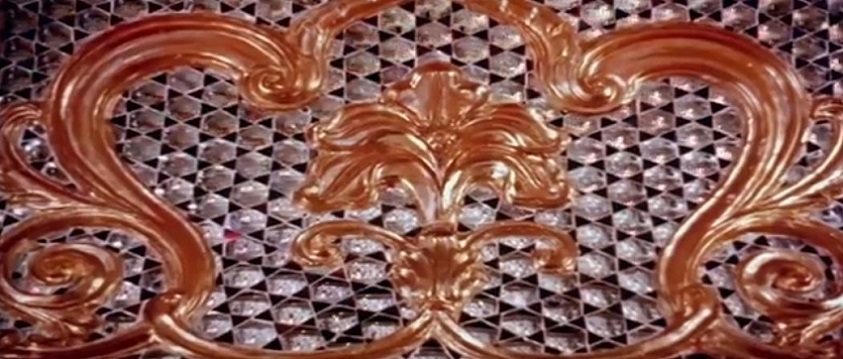
From Mughal e Azam (original Technicolor)
It isn't finished, so a dancing-girl (Madhubala) paints herself the colour of marble and poses in its place. Salim is struck by her beauty, and doesn't even seem too disappointed when she turns out to be alive. Akbar honours her with a new name: Anarkali, meaning pomegranate blossom. He isn't so keen when Salim gets ideas about marrying her.
People
The story of Anarkali is often regarded as legend, though there are snippets of historical evidence for it. She may have been called Nadira Begum or Sharif-un-Nisa, and was possibly a painter of miniatures and/or a courtesan. The English merchant William Finch, who travelled to the Mughal court in the early 1600s, suggested she was one of Akbar's wives and the mother of Salim's half-brother Prince Daniyal.
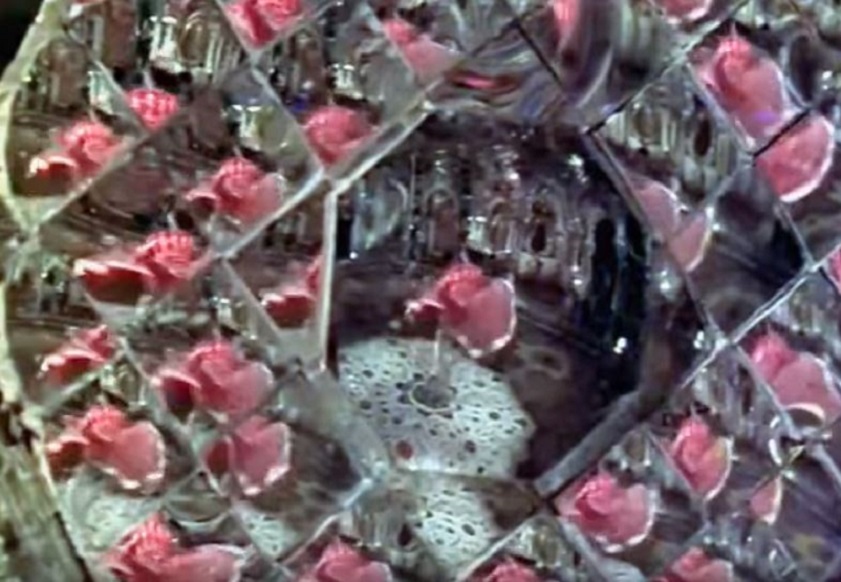
Mughal e Azam
Mughal-e-Azam explores the oedipal element of this story only in terms of the antagonism between Salim and his parents over who gets to make decisions about Salim's life. This is a perennial Bollywood theme, but here it has a basis in fact. The real Salim led a rebellion against his father, tried to replace him as emperor, and had his friend Abu al-Fazl murdered in 1602.
Death
The film ascribes Salim's rebellions against his father to his desire to marry Anarkali, which is definitely not historically accurate. Akbar's revenge is to have Anarkali bricked up in a wall.

The site on which it is supposed to have happened in Lahore has a tomb on it built during Jahangir's reign. Since Mughal times, the Anarkali tomb has been used as a residence, a parish church and a records office.
Film-making
When Technicolor became available in India, director K Asif wanted to reshoot the whole of Mughal-e-Azam (which in any case was in production for 12 years, on and off). By that point, he had already shot three-quarters of it in black and white, and spent many times the usual budget of a Hindi film. His financiers said no. Asif settled for adding some scenes in colour: notably, the gorgeous sheesh mahal (palace of mirrors) sequence.
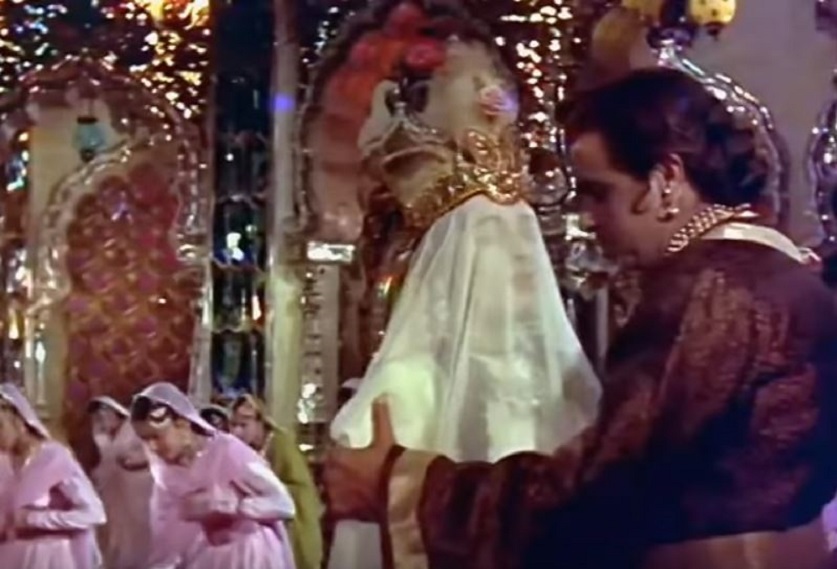
Mughal e Azam
In 2004, a new version of Mughal-e-Azam was released with the rest of the film retrospectively "colourised" and the entire print restored. The restoration was an improvement. As with many other colourisation projects, though, the fake colours tend to look flat and brash, detracting from cinematographer RD Mathur's elegantly composed shots.
Verdict
Mughal-e-Azam is a landmark of cinema, even if its version of history is only slightly more realistic than its new colours.
Theatrical origins, Shapoorji Pallonji and theatrical reincarnation
Malini Nair, COMING TO A THEATRE NEAR YOU: Mughal-e-Azam the play, Sep 25 2016 : The Times of India
A wild prince, a ravishingly haseen kaneez, a powerful emperor and a sobbing mother. And a love that is buried behind a wall by the power of an empire.

Mughal e Azam
Imtiaz Ali Taj's 1922 play Anarkali started it all
Dramatist Imtiaz Ali Taj's play, Anarkali, written in Lahore in 1922, couldn't have packed any more melodrama into his plot about the defiant, doomed love between a prince and a courtesan. It had a small drop of history and large dollops of imagination. Most historians, in fact, believe that Anarkali was Akbar's Persian concubine who may or may not have been eyed by SalimJahangir. But the play made for great theatre. It also went on to become four epic films, one made in Pakistan, three in India. And in 2016 the best known of them, the stunningly opulent Mughal-e-Azam directed by K Asif and released in 1960, returnied to the stage.
The play a majestic musical, promises veteran theatre director Feroz Abbas Khan with crackling one-liners and thundering monologues about mohabbat, sultanat and hukumat, most of the 12 unforgettable Naushad tracks sung live, classic kathak -Pyar Kiya To Darna Kya and the utterly sensuous Mohe Panghat -and costumes designed by Manish Malhotra.

Mughal e Azam
Taking on an iconic film whose dialogues are part of the cultural memories of many generations -remember Kaaton ko murjhane ka khauf nahin hota (thorns are not afraid of drying up) -was a daunting task.
In this age of naturalism in both cinema and theatre, will that bombast -Taqdeerein badal jaati hai, zamana badal jaata hai, mulkon ki tarikh badal jaati hai (luck changes, times change, nations change) -and mawkish romanticism -Main tumhari aankhon mein apni mohabbat ka ikraar dekhna chahta hoon (I want to see my love's acceptance in your eyes) -work? “Naturalism came much later. At one time, dramatists looked for applause. The theatricality and poeticism of Mughal-e-Azam will be a means to revisit the nearly dead classicism in thea tre,“ says Deepa Gahlot, head of theatre and film programming at NCPA.
How Shapoorji Pallonji acquired the rights to Mughal-e-Azam
The NCPA is co-producing the play with construction giant Shapoorji Pallonji which also holds the rights to Mughal-e-Azam. How the Pallonjis came to be associated with the film is a fascinating story where corporate and movie history came together in the late 1940s. It is narrated by film historian Anil Zankar in his book on the film, Mughal-eAzam, and confirmed by the firm's corporate strategist Deepesh Salgia. One of the big film producers of pre-partition India, Shiraz Ali Hakim was setting up Famous Studios at Mahalaxmi in Mumbai. It was being constructed by Pallonji.Ali, who was also at that time producing Mughal-e-Azam, ran out of money to pay the construction firm. He repaid Pallonji by handing over the film's rights to the firm's investment arm, Sterling, and moved to Pakistan.

From Mughal e Azam
The Pallonjis left Mughal-eAzam, a record blockbuster, untouched till they got the film coloured for 2004 re-release. “So when they decided to back the play, it was decided that it had to be mounted on a spectacular scale so that it would pull in even those who don't normally watch theatre,“ says Salgia.
Cast and crew
Director
K. Asif
Cast
Prithviraj [Kapoor] as Emperor Akbar
Madhubala as Anarkali
Durga Khote as Maharani Jodha Bai
Nigar Sultana as Bahãr
Ajit as Durjan Singh
Kumar as Sculptor
Murad as Raja Mann Singh
Jilloo Maa as Anarkali's Mother
Sheela Delaya as Suraiya, Anarkali's Sister
Surinder (guest artist)
Johnny Walker (guest artist)
Jalal Agha as Young Prince Saleem (guest artist)
Gopi Krishna (guest artist)
Baby Tabassum (guest artist)
and
Dilip Kumar as Prince Saleem [mentioned last]
Producer
Sterling Investment Corporation (only producer mentioned in the colour version, 2004)
K. Asif (mentioned as the producer in the 1960 version; with Sterling Investment Corporation mentioned as the Presenters)
Writers
Screenplay: K. Asif, Aman
Dialogues
(Each dialogue writer had a separate Title Card in the credits; this was the importance Asif gave them)
Aman,
Kamal Amrohi,
Ehsan Rizvi,
Wajahat Mirza
Crew
Cinematography
R.D. Mathur, WICA
Colour sequences by
Technicolour [sic] Ltd., London
Editing
Dharamvir
Art Direction
M.K. Syed
Glasswork in Sheesh Mahal
Agha Shirazi
Director of sound
Shaikh Akram ...
Main titles
Ansari (GD Art) ...
Costumes
Jaggi ...
Embroidery
Habib Mirza ...
Jewellery
Umber Jeweller
Song recordists
Robin Chatterji, Kaushik ...
Dance director
Lachchu Maharaj ...
Music
Naushad
Ibrahim, Mohammed Shafi... (assistants)
Lyrics
Shakeel Badayuni ...
Playback singers
Bare Gulam Ali Khan ...
Lata Mangeshkar ...
Mohammad Rafi
Shamshad Begam ...
P. Sushila (old Tamil version)
Krishna Veni (old Tamil version)
(Noor Jehan did NOT sing for Mughal e Azam)
Year of release
1960 (‘Partly in colour’);
Fully colourised version, blown up to CinemaScope, re-recorded with Dolby sound: 2004
Run time
Akbar: the Tamil version
Mughal-e-Azam was dubbed into Tamil and released as Akbar. The film was a flop, but its songs, redone in Tamil by Kambadasan, resonated with an entire generation, notably ‘Kaadhal kondaalé bayamenna’ (Pyar kiya to).
When the colourised Mughal-e-Azam (Hindi-Urdu) was released in 2004 its credit titles were redone and now contained an irritating
kaadhal kondaalE bayamenna by P. Suseela & Chorus, ( tamil equivalent of Lata Mangeshkar's 'pyaar kiya tO darnaa kya ) from the movie 'Akbar 1960 being the dubbed version of
Kaadhalithale Achamenna (ஸ்வர்ணலதா பாடிய இனிய Pyar Kiya to Darna Kya Tamil) by Swarnalatha Teri mehfil
Kambadasan's version in Suseela's voice (1960s recording) was much better!
When Mughal-e-azam was being made simultaneously in Tamil as Akbar, Susheela was called upon to sing for the Tamil version. “There was a lyricist by the name Kambadasan, who would translate the Hindi songs into Tamil. He took me to Bombay and introduced me to the music legend Naushad. Till then, I didn't know who he was. Naushad was very impressed with my rendition of his songs and many decades later, when he was asked to compose for the Malayalam movie Dhwani, he agreed to take up the project on the condition that I sing his songs.“ [http://visionsofcinema.blogspot.in/2016/04/sound-of-music-in-conversation-with-p.html
This song is sung by Kollywood's greatest singer Swarnalatha .The legendary Hindi film Mughal-e-Azam which was released in 1960 with Naushad's score was reconstructed in colour and released in 2006. It was also released in Tamil as Anaarkali. Swarnalatha was the female voice for the songs in the film. Swarnalatha created a stir by singing in two different voices the song 'Kana Neram Unadharuge' which was the Tamil version of the Hindi song 'Mehfil Mein Kismat'. In the original song Lata Mangeshkar and Shamshad Begum had sung the song to which Madhubhala and Nigar Sultana had danced. But in Tamil, Swarnalatha sang for both the dancers in two voices that brilliantly matched them. Naushad who came to Chennai for the Audio release for this film blessed Swarnalatha praising her amazing feat. http://hdvidzpro.com/video/file/Tamil-Version-Of-Mughal-E?id=uJK0sbomx9s
If Kaadhalithale Achamenna by Swarnalatha kavignar vairamuthu is the Tamil version of (Pyar Kiya to Darna Kya Tamil) then what about kaadhal kondaalE bayamenna by P. Susheela???
After several hours of needless research I have come to the conclusion that P. Susheela sang for the 1960 version and Swarnalatha for the 2006 version.
See also
The most expensive Hindi-Urdu films
Dilip Kumar: his films, their box office performance, awards, career
Mughal-e-Azam


